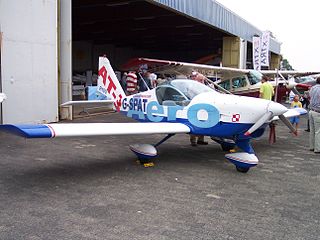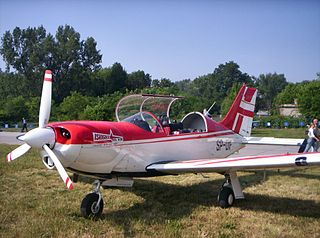
The PZL TS-8 Bies (Devil) is a Polish trainer aircraft, used from 1957 to the 1970s by the Polish Air Force and civilian aviation.

The LWD/WSK Junak was a Polish trainer aircraft, used from 1952 to 1961 by the Polish Air Force and until 1972 by Polish civilian operators. It was designed by the LWD bureau and produced by the WSK Warszawa-Okęcie factory.

The PZL-Mielec M-18 Dromader is a single engine agricultural aircraft that is manufactured by PZL-Mielec in Poland. The aircraft is used mainly as a cropduster or firefighting machine.

The PZL M-15 was a jet-powered sesquiplane designed and manufactured by the Polish aircraft company WSK PZL-Mielec for agricultural aviation. In reference to both its strange looks and relatively loud jet engine, the aircraft was nicknamed Belphegor, after the noisy demon.

The Aero L-60 Brigadýr was a small, high-wing propeller-driven Czechoslovakian STOL utility aircraft developed for both civil and military use. A prototype, designated XL-60, with Argus As 10C engine, first flew on December 24, 1953, but it was not successful. The plane was thoroughly redesigned and the second improved prototype, with M-208B flat-six engine, flew on June 8, 1954. The aircraft's configuration bears a strong resemblance to the Fieseler Fi 156 "Storch" licence-produced in Czechoslovakia during and after World War II, and which this aircraft was intended to replace. By the end of production in 1960, 273 had been built by Aero, including an improved version, the L-160 with an all-metal tail.

The Aero AT-3 is a two-seat, low wing, utility aircraft manufactured in Poland by Aero AT in ready-to-fly certificated form and as a kitplane. The aircraft is of conventional configuration and features fixed tricycle undercarriage. The structure is largely of all-metal construction. Designed by Tomasz Antoniewski it first flew in 1997 and deliveries to customers commenced in 2002. It is certified under the European Very Light Aircraft regulations. On July 2, 2010 Aero AT-3 was granted an American Federal Aviation Administration type certificate, based on its European VLA certification.

The Antonov An-14 Pchelka or Pchyolka, Bdzhilka is a Soviet utility aircraft which was first flown on 15 March 1958. It was a twin-engined light STOL utility transport, with two 300 hp Ivchenko AI-14RF radial piston engines. Serial production started in 1966, and about 300 examples were built by the time production ended in 1972. The An-14 failed to replace the more successful An-2 biplane, which was manufactured until 1990; the An-2 is still manufactured on special order. The An-14's successor, the An-28 with turboprop engines, is still manufactured at PZL Mielec factories in Poland, under the names PZL M28 Skytruck and PZL M28B Bryza.

The PZL Kania is a follow-up design to the Mil Mi-2 helicopter, developed in Poland by PZL-Świdnik.

The PZL-101 Gawron (rook) is a Polish agricultural and utility aircraft designed and built by WSK-Okęcie.

PZL M-4 Tarpan was a Polish trainer and sports aircraft prototype of the 1960s, designed in WSK-Mielec.

PZL M26 Iskierka or M26 Airwolf is a Polish trainer and aerobatic aircraft, designed at WSK PZL-Mielec.

The PZL-106 Kruk is a Polish agricultural aircraft designed and built by WSK PZL Warszawa-Okęcie.
The PZL M-24 Dromader Super is a single engine agricultural aircraft, developed in the 1980s by the WSK-Mielec from the PZL-Mielec M-18 Dromader. It did not progress beyond the prototyping stage.

The PZL-105 Flaming (flamingo) is a Polish short-takeoff-and-landing (STOL) utility aircraft designed by PZL "Warszawa-Okęcie". It remained a prototype.

The PZL S-4 Kania 2 was a Polish trainer and glider towing aircraft of the 1950s, not built in series. The first prototype was designated S-3 Kania. There is also a helicopter named PZL Kania.

The BŻ-4 Żuk, formerly known as GIL-4, was a Polish four-seat light helicopter built in the 1950s. Although it pioneered a novel rotor and transmission system, it never entered series production.

The PZL-102 Kos (blackbird) is a Polish two-seat touring and training monoplane designed and built by PZL.

The PZL M-17 "Duduś Kudłacz" was a Polish twin-boom pusher general aviation and trainer aircraft of 1977, which remained a prototype.

PZL M-2 was a Polish trainer aircraft prototype of 1958, a low-wing monoplane with fixed gear. Designed at WSK-Mielec, it did not enter production.

The PZL M-24 Dromader Mini, originally named the Lama, is a single engine agricultural aircraft, developed in the 1980s by WSK-Mielec from the PZL-Mielec M-18 Dromader. The prototype, registration SP-PDM, first flew on 18 June 1982. It did not progress beyond the prototyping stage.



















